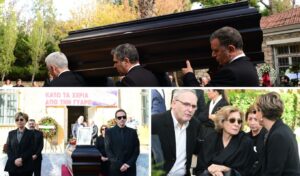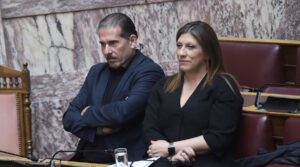Starting today, Wednesday, August 20, citizens can visit their local municipalities to apply for funds related to household goods and emergency aid allowances in areas affected by wildfires, according to Deputy Minister of Climate Crisis and Civil Protection Kostas Katsafados, speaking on First Program 91.6 and 105.8.
Read: Gerapetritis phone call with Ukraine deputy PM: Athens’ unwavering support for Kiev
Kostas Katsafados: The inspection process has been completed
“The inspection process has been completed. Staff from the General Secretariat for Natural Disaster Recovery with their teams visited the affected areas – all of them – complete documentation has been done based on data provided by Local Government, on-site recording was conducted and we held meetings with local officials, the Municipality and the Region, so as to create a tight framework and reduce timeframes around the entire process that will begin for compensation payments. From today, August 20 until September 1, along with the inspection report, their E1 and E9 forms, citizens can go to their Municipality to submit an application. After September 1, all these documents will be sent to the Ministry, the municipalities will send us the supporting documents and papers, so that we can conduct a review and then send the money,” Mr. Katsafados stated characteristically.
“This money for household goods is 2, 4 and 6 thousand euros depending on the grading of damage to each person’s home – for green properties it’s two thousand, for yellow it’s four, for red it’s six thousand and the emergency needs allowance is 600 euros. And naturally for citizens whose homes are classified as yellow and red, they have the opportunity from today, from the next day, to rent a house – the rental subsidy amount starts from 300 euros and reaches up to 500, depending on how many family members there are, and naturally after the Joint Ministerial Decision, which will be issued by the end of September for the demarcation of affected areas, they will be able to submit an application together with a permit for repair or reconstruction of their building, where the state subsidy rate reaches 80%,” he added.
About the 112 system
Regarding criticism about the use of 112 and the discussion about properties at risk, Mr. Katsafados emphasized that “unfortunately we are not experiencing the climate change phenomenon, but the effects of the climate crisis.”
“We are married to the climate crisis, it’s here, it creates very dangerous situations, you see its results, which are tragic across all lengths and breadths of the world. What we do on our part is to protect and fortify ourselves more and more. You know we have an enemy that is very powerful and what we must and should do is use new techniques that emerge each year, use technology, listen to experts, listen to scientists, strengthen the Fire Service in personnel and equipment, and from there try to do our job as best as possible. Our primary goal is that not a single human life is lost. I believe 112 has contributed decisively to this. Then of course it’s to safeguard people’s properties and naturally to protect the natural environment. We try to do this under particularly adverse conditions and we fight a daily battle. (…) Because we have to face a very dangerous enemy, and because it’s an unequal battle most of the time due to weather conditions, we cannot guarantee or commit that suddenly there might be wind gusts that could reverse a fire’s course and where a house, residence or settlement didn’t appear to be in danger, suddenly we find ourselves at risk and a settlement hasn’t been evacuated. You understand then that this is a tool that has saved lives,” he added.
“There’s no comparison measure on the scale for this thing. We believe that human life is an invaluable asset, above any property. And I think every person understands and agrees on this issue,” Mr. Katsafados further emphasized.
Regarding the fact that there are citizens who complain they were called to evacuate their homes and there were no fire forces to protect their properties, Mr. Katsafados noted “when we have a fire front of many kilometers, there cannot be a fire vehicle every ten meters. I think this is understandable and this has to do with the Fire Service’s operational function, where obviously I cannot know – there are experts who know better and are highly capable Fire Service personnel, who determine the method of confronting and combating the fire and naturally where they will set up their defense line, where they will place fire vehicles and where they will place teams. You understand we cannot all be experts in everything. This work is assigned to be done by the Fire Service’s top personnel. Let me inform you that everywhere and in all fires there was a senior Fire Service officer who went on site to coordinate ground and air forces. It was a very great effort. In all fires there was vehicle transfer, personnel transfer, coordination and cooperation between police and other security forces, armed forces, volunteers who helped decisively and we must congratulate them, first and second level local government, and this if you will is an achievement, an achievement for the country, the cooperation framework that now exists.”
Asked finally if operationally the fire management appeared to function correctly, Mr. Katsafados emphasized that “obviously if there were any service failures, these will be judged, examined and judged.” “From there on, I am not the one who has the know-how to judge if and where mistakes occurred. There are others who are responsible for this thing and naturally after each fire, two other procedures are followed. The first has to do with the Fire Service investigation, which goes to see how the fire was caused, how this fire happened, how this fire source broke out. And the second of course is to check and see if indeed the operational plan that was applied was effective, functional and if not, to assign responsibilities. (…)
At the time the Patras fire broke out, you should know, both you and your listeners, that five different fires broke out in Patras.
Apart from the fact that all of Western Greece was burning due to the weather phenomena prevailing and which we had characterized as being at the highest danger level and all Fire Service personnel were on full alert, it was at red level, level 5 throughout Western Greece due to the prevailing weather conditions, I should tell you that the fire that broke out in Patras was not one. There were five different fires within half an hour to an hour of each other and naturally a very dangerous fire that broke out at ten o’clock at night. You understand then that we continuously had force redeployment, there was continuous force redeployment because the Fire Service had to respond to all fronts,” Mr. Katsafados concluded.




